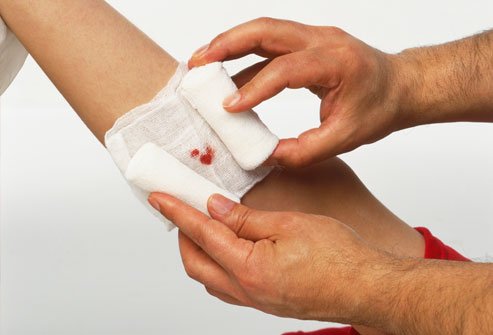Bleeding wounds

Deep wounds do not always result in severe bleeding, and in most cases bleeding is minor.
This type of wound is automatically healed, and this does not mean that treatment is not required or unnecessary. The person is exposed to this type of wound when scratching nails, or when hit with sharp tools such as nails, but the risk comes from the opportunities for infection and intended infection of tetanus or any other types of bacteria, especially if the tool that caused the injury was exposed to soil. Such wounds are produced from the bite of the animal and humans as well, and include any pet bite of cats and dogs and the resulting wounds are susceptible to infection. If they are deep enough to cause bleeding, consult your doctor. Otherwise, follow these steps:
Stop bleeding:
The wound or surfactant stops their bleeding automatically. But if there is a severe bleeding, you have to squeeze the wound with a clean bandage or cloth, but if the blood continues to flow after pressing the wound, seek medical advice immediately.Cleaning the wound:
Clean the wound with flowing water, do not use soap because it is likely to irritate the wound, and if there are some dust and granules are still present in the wound and did not respond to water you can use a disinfectant disinfectant alcohol to get rid of them, and dust and contaminants deep within the wound do not try to remove yourself, the doctor. Cleaning the wound and surrounding areas reduces the chances of tetanus infection, and uses soap to clean areas around the wound. You can also use oxygen or water. These substances can cause irritation of living cells so it is advisable not to use them directly on the wound.
3 - the use of antibiotics:
After cleaning the wound well, apply a light coat of cream or antibiotic ointment such as: Neosporin or Polysporin. These antibiotics help to keep the skin moist, but it does not fast heal, it helps to fight the infection, and allows factors Body healing works more efficiently for healing. Certain compounds in the ointments cause skin rash in some people and as soon as they appear, they should be immediately avoided.
- Cover wound:
Exposure to the air increases the speed of acclimatization, but its coverage helps to keep it clean and not exposed to harmful bacteria, you should cover with a medical adhesive (Blaster) or bandage until the full outer shell.
Change dressings:
Bandages change daily or when they become dirty or become wet. Many people are allergic to some types of bandages with adhesive, and you can use other non-stick types to make up for them.
Observation of signs of infection:
Consult your doctor immediately if the wound does not respond to treatment, or if you notice redness, swollen, hotter, or a wound.Tetanus vaccination.
I hope you like the article❤

You got a 4.41% upvote from @upmyvote courtesy of @lhecenam!
If you believe this post is spam or abuse, please report it to our Discord #abuse channel.
If you want to support our Curation Digest or our Spam & Abuse prevention efforts, please vote @themarkymark as witness.